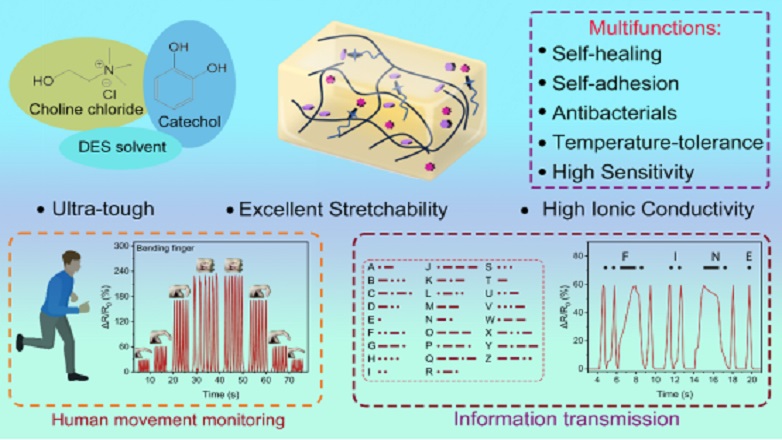
Recently, researchers from the Institute of Bast Fiber Crops at the Chinese Academy of Agricultural Sciences, in collaboration with Central South University, developed a multifunctional eutectogel using acrylic acid and choline chloride-catechol as raw materials. The research findings were published in the Journal of Materials Chemistry A.
Ionically conducting eutectogels have gained popularity as temperature-tolerant and cost-effective candidates for flexible and wearable electronic devices. Chemical crosslinking is commonly used to enhance the mechanical strength of polymer eutectogels. However, there have been few reports and studies on tough polymer eutectogels relying solely on physical entanglement and exhibiting antibacterial activity. In this study, at low initiator concentrations, vinyl monomers (acrylic acid) underwent radical polymerization in deep eutectic solvents (choline chloride-catechol) under UV irradiation, forming physically entangled and transparent eutectogels. This process is simple and rapid. The team utilized hydrogen bonding, electrostatic interactions, and π–π interactions between acrylic acid and choline chloride-catechol to prepare a tough and multifunctional eutectogel. The eutectogels exhibited excellent mechanical properties, self-adhesive ability, ionic conductivity, and remarkable resistance to freezing and drying. Moreover, they possessed superior self-healing abilities at room temperature without the need for external stimuli. As sensors, the fabricated eutectogels exhibited high sensitivity, enabling precise, real-time, and stable monitoring of human activities and the transmission of information. These eutectogels hold promising applications in wearable technology, healthcare devices, and human-computer interfaces
The research was supported by China Agriculture Research System for Bast and Leaf Fiber Crops, the Science and Technology Innovation Project of the Chinese Academy of Agricultural Sciences, and so on.
The study entitled “Physically entangled multifunctional eutectogels for flexible sensors with mechanically robust” has been published the Journal of Materials Chemistry A and can be accessed through the following link: https://doi.org/10.1039/d4ta02751e

Fig. 1. The preparation and application of multifunctional eutectogel for flexible sensing.

